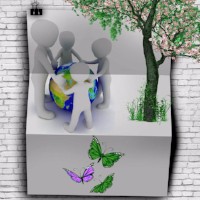
Do your students enjoy cute animal videos on YouTube? Do they think parks and beaches are fun places to play games and hang out? Are they interested in doing their part to make the world a better place?
If your students answer yes to any of these questions, Earth Day just might be an event they could get excited about.
Earth Day is celebrated around the world every April 22nd. Since 1970, the organizers of Earth Day have been protecting endangered species and fighting pollution, while promoting civic engagement and education. They encourage everyone to learn more about the natural environment and the animals and plants that we all rely on for a healthy planet.
Every year, in celebration of Earth Day, organizers gather volunteers to clean up parks, plant trees, and recycle as much paper and plastic as they can find. Community leaders mobilize their residents to communicate important messages about ecology and climate change. Teachers and students around the world plan educational activities and events to promote awareness of environmental issues impacting all of us.
Incorporating Earth Day Activities into Your Spanish Classroom
Opportunities to participate in Earth Day abound in your Spanish classroom. Students can make connections between Spanish and other subjects they are studying, like art, science and geography while thinking about the important issues that surround Earth Day.
As Earth Day approaches, encourage your students to get involved in their communities and to participate in these Spanish class activities. After all, Earth Day is a perfect opportunity to get your students thinking about the wider world in which they live and communicate, in English and in Spanish!
6 Earth Day Activities for Individuals & Groups
Beginning Spanish speakers will enjoy these two Earth Day activities that combine artistic expression with Spanish vocabulary building.
 1. A Project for Individual Students: Earth Day Public Service Announcement (PSA) Posters
1. A Project for Individual Students: Earth Day Public Service Announcement (PSA) Posters
Learning objective: Students will create posters for Earth Day with slogans written in Spanish.
How to do this activity: Prepare for the activity by selecting vocabulary words in advance according to the theme of endangered species. Gather art supplies like marker pens, paint and brushes, magazines, glue and scissors.
Start with a list of ten new animal words, or if you would like to offer a challenge, start with a list of twenty animal words and schedule an assessment for the end of the week. Distribute the vocabulary lists and discuss with them briefly the risks these animals might face as a result of pollution and climate change.
Assign each student a specific animal and ask them to create a poster that contains a Public Service Announcement about their animal that begins with ‘protejamos’ (let’s protect); for example, ‘Protejamos pinguinos! Por favor!’ (Let’s protect the penguins! Please!). The students can illustrate their posters with drawings, paintings, and collages. Post finished PSA posters in the classroom or around the school.
 2. A Project for Small Groups: Postcards from the Planet
2. A Project for Small Groups: Postcards from the Planet
Learning objective: Students will create visuals for Earth Day while writing introductions and greetings in Spanish.
How to do this activity: Like above, prepare for the activity by selecting animal vocabulary words in advance. Gather art supplies like marker pens, paint and brushes, magazines, glue and scissors.
Divide students into groups of four, and assign each student a task: one student will research the habitat of the animal and tell the rest of the group about the habitat, one student will draw or collage the habitat on the postcards, one student will draw or collage the animal, and one student will write the message on the back of the postcard from the animal introducing itself.
Each group will receive three blank index cards as their postcards. By the end of the activity, each of the three postcards will contain a message from a different animal that has been illustrated in its own habitat.
Intermediate Spanish speakers can practice writing in the future and conditional tenses in response to Earth Day-related writing prompts.
 3. Personal Writing: Letters to the Editor
3. Personal Writing: Letters to the Editor
Learning objective: Students will understand the impact of writing letters to the editor while practicing Spanish writing skills.
How to do this activity: Ask students to find a news article related to an environmental concern and bring it with them to class. In class, ask students to discuss their articles briefly. Get argumentative writing juices flowing by asking the class: ‘Why should other people know more about this environmental issue?’
Then explain to the class that letters to the editors are letters written by the readers of a newspaper or magazine about specific concerns. Writers send these letters to the editor hoping the letters will be published so others can read about the concern and perhaps develop an interest of their own in the issue.
Then, give the students class time to write in Spanish their own letters based on the news article they brought in. Encourage them to use their dictionaries to look up new vocabulary words and to write using basic sentence structure.
If students are new to writing in Spanish, consider giving the students participation grades rather than grades assessing their actual writing skills.
 4. Creative Group Writing: The Importance of the Environment
4. Creative Group Writing: The Importance of the Environment
Learning objective: Students will practice following instructions and cooperative learning while practicing Spanish writing skills.
How to do this activity: This activity works best with a small class of less than ten students, or in groups of five or six students each. Allow students to use their dictionaries to bring more creativity to this activity.
Prepare for the activity by creating a list of ten or twelve questions that you would like them to answer to create an Earth Day story; another option is to brainstorm the questions as a class. Some example questions include: What animals do I see? What are we all eating? What kind of weather are we experiencing?
To begin the activity, explain to your students that they will be writing a story as a group; the success of the assignment depends on their listening carefully to the questions you will ask. All the questions will have to do with nature or the environment so that they can think about Earth Day themes as they write. Ask the students to take out a sheet of blank lined paper and to write their names at the top of the page. Tell the students that you will ask them a series of questions and they must all be answered in the first person with yo (I) statements.
Ask the first question: Where am I? Students will write their answers in Spanish at the top of the page and then fold the paper to hide their answers. Then students will pass their papers to the right so that they are all ready to write on a classmate’s paper. Ask the second question: Who is with me and what are we doing? After students write their answers, they fold the paper over and pass it to the right again. Continue with this process until all of your questions are answered.
Ask students to return the paper to the person whose name is at the top, and ask students to read their stories to their small groups or to the class as a whole. Don’t worry if the stories don’t always make sense–that is half of the fun!
Advanced Spanish students can sharpen their communication and presentation skills with Earth Day research projects. Older students will benefit from basic guidelines, and they will enjoy having most of the control over the final product.
5. Earth Day Travel Guides: Exploring the Geography of Spanish-speaking Countries
Learning objective: Students will use map and research skills to create written guides about any of the 22 Spanish-speaking countries.
How to do this activity: Begin this activity by asking students where they might like to go to practice their Spanish. Allow students to talk about why a particular Spanish-speaking country interests them.
Ask students to research outdoor activities that are enjoyable in the country of their preference and to focus their travel guides around these activities. Each student will create a brief guide to their country focusing on outdoor activities and the landscape of their country.
You choose the word minimum and whether or not you would prefer maps and illustrations. The students have the freedom to organize their guides as they like. Each student must present their guides informally in class on the due date.
 6. News Flash: Team Reports about the Climate and the Landscape from Abroad
6. News Flash: Team Reports about the Climate and the Landscape from Abroad
Learning objective: Students will use research and writing/speaking skills to present information to the rest of the class.
How to do this activity: Divide students into pairs and explain that they will be creating an environmental news report to film or to perform in front of the class. One student must be the news presenter in the home country, and the other student will be the reporter abroad with a news flash about an environmental happening in the Spanish-speaking country.
Ask students to research and create a five-minute interview in Spanish between the news presenter at home and the reporter abroad. Students will then have the opportunity to present their news flashes to the rest of the class.
Here are more Spanish Class Activities.